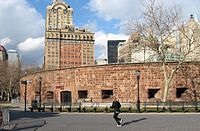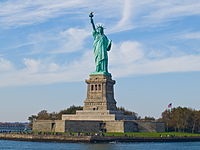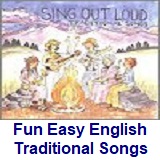|
New York Stories |
|
|
Immigrant Life in New York
Almost all of us have relatives who came from someplace other than
the United States. People who came to America to live are called
immigrants.
From the 1850s through the early 1900s, thousands of immigrants
arrived in the United States and lived in New York City. They first
came from Ireland and Germany and later from Italy, Eastern Europe,
and China, among other places. Because most immigrants were poor
when they arrived, they often lived on the Lower East Side of
Manhattan, where rents for the crowded apartment buildings, called
tenements, were low.
The Lower East Side Tenement Museum is in a building that used to be
a tenement and it tells the story of immigrants in the City. It was
built in the 1860s and could house 20 families, four on each floor.
Each apartment had only three rooms: a living or "front" room, a
kitchen, and a tiny bedroom. Often seven or more people lived in
each apartment. Not only was the tenement crowded, but also, until
1905, there were no bathrooms inside the building. Residents also
did not have electric power until after 1918.
The Museum has re-created the apartments to look like they did when
families lived there. This photograph shows what the Rogarshevksy
family's kitchen looked like in 1918. Abraham and Fannie
Rogarshevsky arrived with their four children from Russia in 1901.
Later, they had two more children in the United States. While they
lived in this tenement, a boarder (someone who pays for food and
lodging in another person's home) lived with the family. That would
have made nine people living in a three-room apartment! |
|
|
Montauk Point Lighthouse Museum
You may think that lighthouses are interesting to look at, and they
are. But they also serve a very useful purpose.
Lighthouses guide ships sailing near a coast. They are built in
different kinds of places: important locations on a coast, harbor
entrances, islands, rocky ledges or reefs, and even in the water.
They project strong beacons of light at night so ships can see them.
Lighthouses help ships identify their locations, warn them of
danger, and serve as a marker of nearby land.
The Montauk Point Lighthouse on Long Island, New York, is more than
200 years old. Built in 1796, it is the oldest lighthouse in the
state. It has guided whaling ships, fishing boats, steamships,
submarines, and sailboats for many years and continues to do so
today. The tower is more than 110 feet tall, and a person has to
climb 137 steps to get to the top. But the Montauk Point Lighthouse
is not just a tower. Attached to it is a house in which the
lighthouse keeper lived with his family and assistants. Since the
light on top of the tower was automated in 1987, the lighthouse no
longer needs a keeper. |
|
|
One-Room Schoolhouse
Would you like to experience what going to school was like in the
late 1800s? To start with, imagine everyone in school sharing only
one teacher and one classroom.
In the 19th and early 20th centuries, most American students
attended a one-room schoolhouse. A single teacher would typically
have students in the first through eighth grades, and she taught
them all. The number of students varied from six to 40 or more. The
youngest children sat in the front, while the oldest students sat in
the back. The teacher usually taught reading, writing, arithmetic,
history, and geography. Students memorized and recited their
lessons.
The classroom of a one-room schoolhouse probably looked much like
your own. The teacher's desk may have been on a raised platform at
the front of the room, however, and there would have been a
wood-burning stove since there was no other source of heat. The
bathroom would have been outside in an outhouse.
In Honeoye Falls, New York, there is a one-room schoolhouse where
kids today can experience what it was like to be students in the
late 19th century. For a week during the summer, they wear 19th
century clothes and learn the way children learned more than a
hundred years ago.
What else has changed about school since the 19th century? |
|
|
Rochester, New York's Lilac Festival
The Netherlands is known for its tulips. Rochester, New York, is
known for another type of flower - the lilac.
There are more than 500 varieties of lilacs and more than 1,200
lilac bushes at Highland Park. In 1888, the world's largest nursery,
Ellwanger & Barry, owned by George Ellwanger and Patrick Barry, gave
Highland Park to the people of Rochester. It was beautifully
landscaped with trees and shrubs and was the first municipal
arboretum in the United States. An arboretum is a place where trees,
shrubs, and plants are specially grown and cultivated. The park's
collection of lilacs originally started with 20 varieties in 1892.
Since 1898, Rochester has held a Lilac Festival every May. The first
event attracted 3,000 visitors; now more than 500,000 people come to
see the lilacs and other flowering trees and shrubs.
Lilacs are shrubs and small trees that flower in the spring and
early summer. They have large oval clusters of small blossoms and
deep green leaves. The blossoms are fragrant and can be lavender,
deep purple, white, or pink. Lilacs are originally from Eastern
Europe and Asia and were brought to North America by early European
settlers. Some of the first lilacs planted at Highland Park are
descendants of the flowers from the Balkan Mountains in Eastern
Europe. |
|
|
Little Falls Canal Celebration
The kids in the photo are competing in their town's Youth Fishing
Derby to see who can catch the most fish. The event is part of the
Little Falls, New York, Canal Celebration -- an annual festival that
celebrates the importance of the Erie Canal to the city.
In the early 1800s, there were few roads, so the shipping of goods
over land was expensive. The construction of the Erie Canal in the
1820s helped solve this problem for travel through New York state. A
canal is a man-made waterway through which boats can navigate. The
Erie Canal connected Buffalo on the eastern shore of Lake Erie to
Albany on the upper Hudson River, which ran south to New York City.
The canal allowed people and supplies to move between New York City
and Buffalo and on to the upper Midwest territories. What used to
cost $100 to ship by land now cost only $10 by canal. A journey that
used to take a few weeks could now be made in less than seven days.
The Erie Canal was an important force in the economic development of
the area. |
|
|
Solomon Northup Day
Before the Civil War, if you were black and born a free man you
could still be forced into slavery. That's what happened to Solomon
Northup.
Northup was born a free man in Minerva, New York, in 1808. He was a
carpenter and talented fiddler. In 1834, he and his wife moved to
Saratoga Springs, New York, where they had three children. In 1841,
Northup met two men who claimed to be from a circus. Because he
needed the money, Northup agreed to join them as a fiddler in
Washington, D.C. Once they reached Washington, however, the men
drugged, chained, robbed, and sold him to a slave trader.
Northup was shipped south to New Orleans, along with other slaves,
where he was sold in a slave market. He spent the next 12 years as a
slave, working for three masters. Northup worked hard and endured
much cruelty, but he was always looking for the chance to escape or
contact his family and friends in New York. Finally, in 1852,
Northup befriended Samuel Bass, a Canadian carpenter. With his help,
Northup sent a letter to his friends in New York. Through the help
of his friends, he regained his freedom in 1853. Northup returned to
New York, where he was finally reunited with his family.
Northup wrote a memoir, Twelve Years as a Slave, about his
experiences. But this book isn't his only legacy. Northup has many
descendants, who gathered together in Saratoga Springs on July 24,
1999, for a tribute to their ancestor. The town of Saratoga Springs
declared July 24 as Solomon Northup Day to remember the suffering of
Northup and other African Americans who lived as slaves. |
|
|
Walking Onto Ellis Island, New York
Do you know what important activity once took place at Ellis Island?
In the late 19th and early 20th centuries, many immigrants came to
New York through an immigration station called Ellis Island, near
the southern tip of New York City's Manhattan Island. Immigrants,
people who leave their home country to live permanently in a new
one, have made up a large part of the population of New York City
for several hundred years. Irish, Italian, Jewish, Puerto Rican, and
other people have influenced the cultural makeup of this huge city.
Between 1892 and 1954, more than 12 million immigrants passed
through Ellis Island in order to start a new life in the United
States. They came to escape religious persecution, political
oppression, and poverty in their home countries. Getting through
Ellis Island, however, was often a long and grueling process. Newly
arrived immigrants had to wait in line for many hours, endure
medical examinations, and answer questions from the immigration
inspectors. |
|
Source:
Library of Congress |
|
 National
Forests and Monuments of New York National
Forests and Monuments of New York
The following is a description of national
forests and monuments in the state
of New York. There are no national parks in
this state. If you plan to visit or live in
New York for awhile then you should
definitely plan to visit some of these
fantastic places. |
|
|
|
National Forests |
 Finger
Lakes Finger
Lakes
Located between Seneca and Cayuga lakes,
Finger Lakes National Forest is one of the
smallest National Forests. The Gorge Trail
enters a small gorge in the forest, and the
North Country Trail crosses part of the
forest. |
|
|
|
National Monuments |
 African
Burial Ground African
Burial Ground
Re-discovered in 1991 during excavations for
a new federal building, this former burial
ground that contains the remains of more
than 400 free and enslaved Africans buried
during the 17th and 18th centuries was
designated a National Historic Landmark
memorial in 1993. |
 Castle
Clinton Castle
Clinton
A circular sandstone fort built in 1811 at
the southern tip of Manhattan to protect New
York City from the British, Castle Clinton
is now located in Battery Park. It later
became a beer garden, a theater, the first
immigration station (predating Ellis
Island), and a public aquarium. |
 Fort
Stanwix Fort
Stanwix
Fort Stanwix guarded a strategic 18th
century portage known as the Oneida Carrying
Place. It was built during the French and
Indian War (1754–1763). The fort
successfully resisted the 1777 siege by a
British invasion army during the Saratoga
campaign of the American Revolutionary War.
Erased by the development of Rome, New York,
it was rebuilt as a national monument in the
late 1970s. |
 Governors
Island Governors
Island
From 1783 to 1966, Governors Island in New
York Harbor was an Army post, and from 1966
to 1996 it was a Coast Guard installation.
Located on Governors Island are Castle
Williams and Fort Jay, which served as
outposts to protect New York City from sea
attack. |
 Statue
of Liberty Statue
of Liberty
This iconic statue, built in 1886 on Liberty
Island and 151 feet (46 m) tall,
commemorates the centennial of the signing
of the United States Declaration of
Independence and is a gesture of friendship
from France to the U.S. Liberty Enlightening
the World is a symbol of welcoming
immigrants to the U.S. and is listed as a
World Heritage Site. Ellis Island, where 12
million immigrants entering the U.S. passed
through, is included in the monument. This
national monument is also partially located
in the state of New Jersey. |
 Stonewall Stonewall
The Stonewall Inn, often shortened to
Stonewall, is a gay bar and recreational
tavern in New York City and the site of the
Stonewall riots of 1969, which is widely
considered to be the single most important
event leading to the gay liberation movement
and the modern fight for LGBT rights in the
United States. Also included in the 7.7 acre
site is Christopher Street Park, across the
street. |
|
|
Cool America |
 About the U.S.A. About the U.S.A.
About the U.S.A. is an American
Studies reader that examines the customs, government, and history of the
United States of America. The text provides a wealth of information on U.S.
geography and history; the roles of local, state, and federal government;
national holidays and symbols; the Constitution; and citizenship. The book,
which was written for intermediate to advanced learners of English, contains
a range of activities for language students to practice listening, speaking,
reading, and writing. (opens to a new PDF window)
Great English reading
practice. |
 About
America About
America
Learn about the fascinating history and government of
the United States of America. Lessons include content on
American Government, American History, and Integrated
Civics. Handouts with interactive games and
student-centered activities encompass all four language
skills: speaking, listening, reading, and writing.
Great English reading practice for
beginning to intermediate students. |
 American Teens Talk! American Teens Talk!
Americans Teens Talk! is a collection of interviews of
American high school students. Each interview is accompanied by vocabulary
notes and discussion questions. The interviews in American Teens Talk! give
learners a view into the lives of adolescents in the U.S. Through the
written format of the interviews, learners are able to increase their
vocabulary, practice their reading and listening skills, engage in
discussions, and learn more about U.S. culture. These
interviews come with audio programs.
Great English listening and
reading |
 Sing Out Loud Children's Songs Sing Out Loud Children's Songs
Sing Out Loud Children's Songs includes popular children's songs in the U.S.A. Posters accompany the
individual Sing Out Loud Children's Songs. These
songs come with audio programs.
Great English listening and reading
practice. |
 Sing Out Loud Traditional Songs Sing Out Loud Traditional Songs
The Sing Out Loud Traditional Songs
collection contains 13 traditional American folk songs and song lyrics.
Listen to the songs online, read the lyrics, and collect the posters that
accompany the songs. These
songs come with audio programs.
Great English listening and reading
practice. |
 Sing Out Loud American Rhythms Sing Out Loud American Rhythms
Do you love music? Want to use it
to learn English? Check out the hip-hop inspired song "Peace" from Sing Out
Loud American Rhythms. American Rhythms includes a variety of musical genres
from many different artists in the U.S.A. These songs will appeal to teens
and young adults. These
songs come with audio programs.
Great English listening and reading
practice. |
 Route
66 - Famous American Road Route
66 - Famous American Road
U.S. Route 66 (US 66 or Route 66), also known as the Will Rogers Highway, the
Main Street of America or the Mother Road, was one of the original highways in
the U.S. Highway System. The highway, which became one of the most famous roads
in the United States, originally ran from Chicago, Illinois, through Missouri,
Kansas, Oklahoma, Texas, New Mexico, and Arizona before ending in Santa Monica,
California, near Los Angeles, covering a total of 2,448 miles (3,940 km). It was
recognized in popular culture by both the hit song "(Get Your Kicks on) Route
66" and the Route 66 television show in the 1960s. |
Route 66: The Highway That's the Best
(Beginner - Listening)
A video lesson which shows you an interesting place in America.
The English is
spoken at 75% of normal speed.
Great English listening practice.
This video shows travel along Route 66, the most famous road in
America. |
Chicago: The Start of Route 66
(Beginner - Listening)
A video lesson which shows you an interesting place in America.
The English is
spoken at 75% of normal speed.
Great English listening practice.
This video shows travel along Route 66, the most famous road in
America. |
Going West for Decades on Route 66
(Beginner - Listening)
A video lesson which shows you an interesting place in America.
The English is
spoken at 75% of normal speed.
Great English listening practice.
This video shows travel along Route 66, the most famous road in
America. |
Arizona: The Spirit of Route 66
(Beginner - Listening)
A video lesson which shows you an interesting place in America.
The English is
spoken at 75% of normal speed.
Great English listening practice.
This video shows travel along Route 66, the most famous road in
America. |
Route 66 California: The End of the Trail
(Beginner - Listening)
A video lesson which shows you an interesting place in America.
The English is
spoken at 75% of normal speed.
Great English listening practice.
This video shows travel along Route 66, the most famous road in
America. |
Ten Must-See Route 66 Attractions
(Beginner - Listening)
A video lesson which shows you an interesting place in America.
The English is
spoken at 75% of normal speed.
Great English listening practice.
This video shows travel along Route 66, the most famous road in
America. |
Four Famous Foods On Route 66
(Beginner - Listening)
A video lesson which shows you an interesting place in America.
The English is
spoken at 75% of normal speed.
Great English listening practice.
This video shows travel along Route 66, the most famous road in
America. |
International Tourists Drawn to Route 66
(Beginner - Listening)
A video lesson which shows you an interesting place in America.
The English is
spoken at 75% of normal speed.
Great English listening practice.
This video shows travel along Route 66, the most famous road in
America. |
|